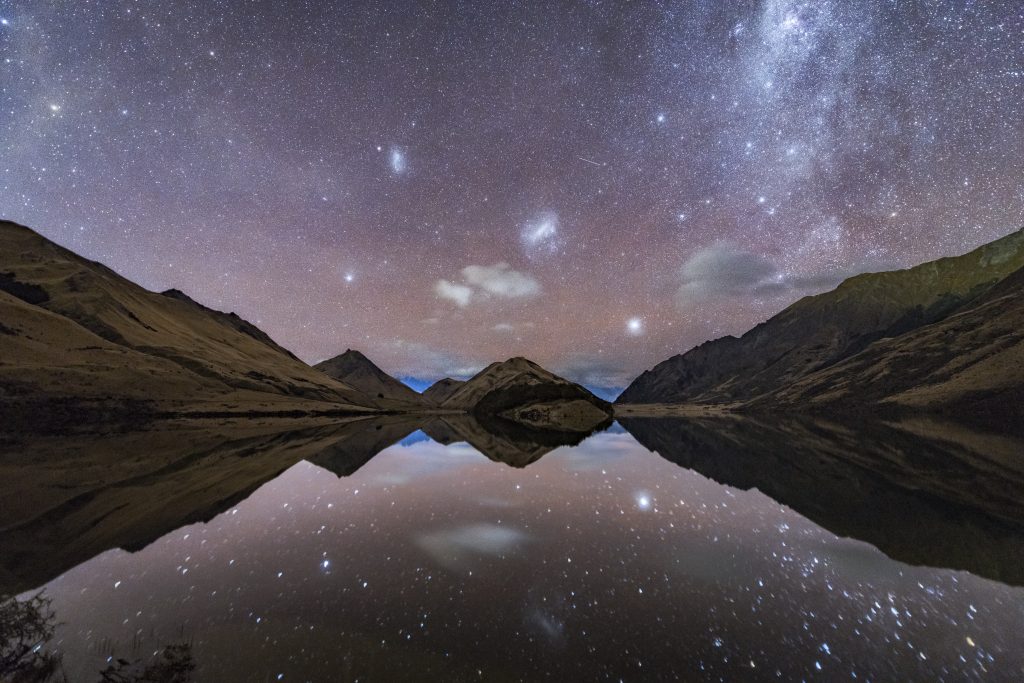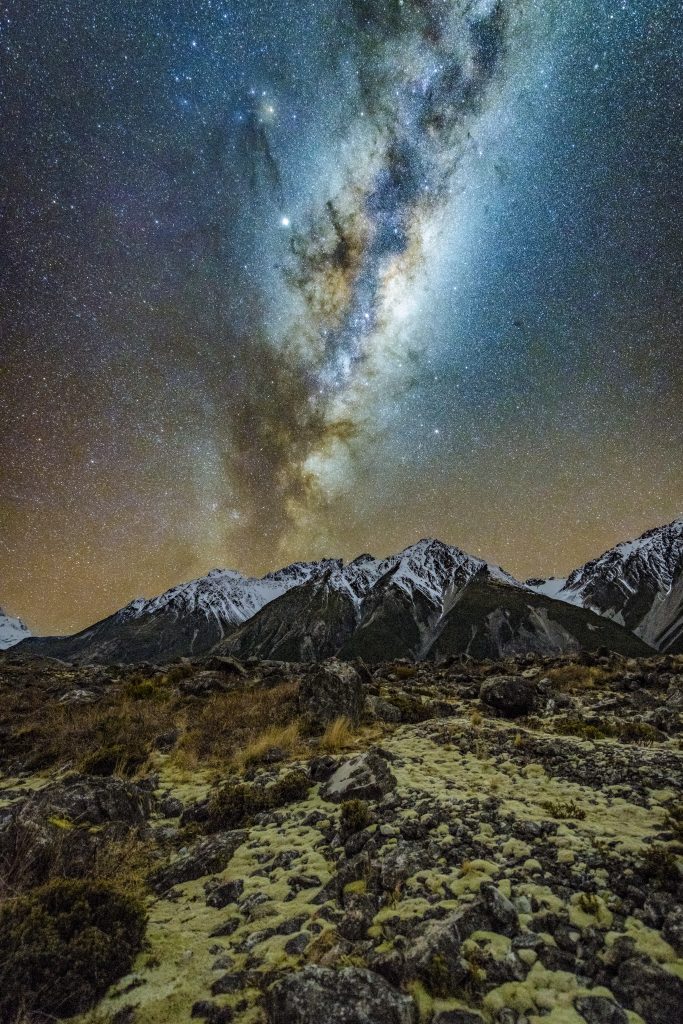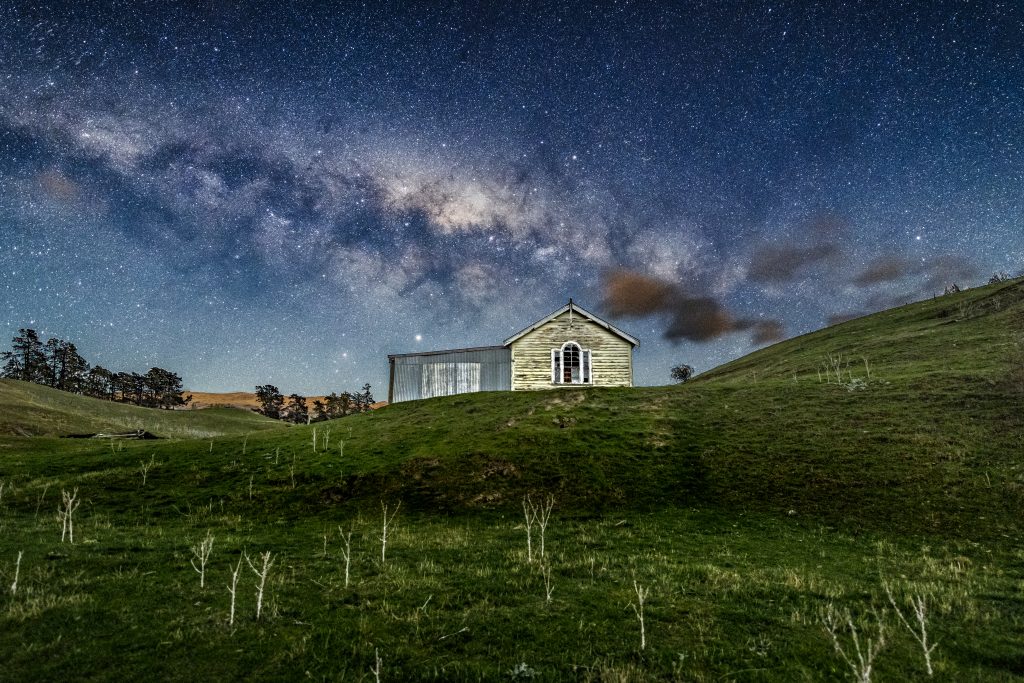Astrophotographer Simon Williams can see in the dark.
PERFECT PITCH BLACK: IT’S NOT AS EMPTY AS YOU THINK. WAIT IN THE DARK, AND YOU’LL FIND IT TAKES AROUND TEN MINUTES FOR HUMAN EYES TO ADJUST TO DARKNESS. IN THAT TIME, SOMETHING SPECIAL HAPPENS. AS THE LACK OF LIGHT DEPRIVES YOU OF ONE OF YOUR MAIN SENSES, THE OTHERS TAKE OVER. THE SLIGHTEST SOUNDS RING CLEARLY. A WEAK BREATH OF WIND GLIDES NOTICEABLY ACROSS YOUR FACE. YOUR FEET TELL YOU THAT THE SURFACE YOU ARE STANDING ON ISN’T REALLY FLAT. YOUR CONNECTION TO THE PLACE ON WHICH YOU STAND IS AMPLIFIED, NOTICEABLY. I FIND MYSELF IN THESE SITUATIONS OFTEN – IN FACT, I ACTIVELY SEARCH THEM OUT. I’M AN ASTROPHOTOGRAPHER. I TAKE PICTURES OF THE STARS.
As the name suggests, astrophotography is a genre of photography that uses astronomical objects as its subject. In this genre, gear really does make a difference. A good, fast, wide lens and a back that handles low light really well are key, as is a good sturdy tripod. Basically, the Hubble Space telescope is at one end of the spectrum, and a fancy-ish smart phone with a basic tripod sits at the other.
Visual access to the night sky is also a prerequisite. For the most part, the nightscape as viewed from Earth looks as it did, ten, twenty, fifty, a hundred, a thousand years ago. It’s the same sky used by brave early explorers to navigate their waka across the vast ocean to discover, and return to, Aotearoa. Today, the stars as seen from our beautiful land are renowned for being some of the clearest and most accessible on the planet.
“LIGHT TRAVELS A REALLY LONG WAY, REALLY QUICKLY, AND IT ADORES BOUNCING OFF EVERYTHING IN ITS PATH.”
Unfortunately, finding dark skies is becoming more difficult the world over. Light travels a really long way, really quickly, and it adores bouncing off everything in its path. Humans, in turn, have a fixation with creating objects that emit vast amounts of light. It doesn’t take much ambient light to obscure astronomical objects and our collective ‘growth’ is impacting on our ability to take in the stars and planets, especially with the naked eye.

There are other factors at play. Thousands of satellites have been launched recently in the name of profitable global Internet infrastructure. You may have seen these as a series of bright objects traversing the night sky – some compare them to a string of pearls – in the first couple of hours after sundown. It’s an incredible sight, but it’s also a reminder of the human race’s appetite for colonising and controlling the natural world. Some don’t think this matters, while others see the night sky for the taonga it is. These folk, my kinda folk, would argue this aspect of our increasing disconnect from our natural world contributes to the many social and wellbeing issues we face. Humans need to see the stars.
Ko au ko te taiao, ko te taiao ko auI am the environment and the environment is me
TIME AND PLACE
Living in the Deep South, I’m spoilt for choice when it comes to shooting starscapes. I’m surrounded by truly dark places that are also astonishingly beautiful. While I sometimes stumble across an amazing composition, finding that epic shot, more often than not, takes planning. Thankfully, the night sky is extremely predictable, as humans have been studying it for thousands of years. Most of the information I need is readily available at the touch of a keyboard, though I do remember doing the calculations by hand in my university years. It’s a game of time and place. Celestial objects rise in the east and set in the west – always. The time and position of their ascension depends on where, and when, I am. Sometimes I have to wait eleven or twelve months to get the composition I want with the right weather window.
As I stand in a place, I often think about my location in the universe. I’m on a planet, which is spinning around a wobbling axis. There’s a moon, which appears to orbit us at a different rate to our spin; sometimes we see the whole of it, other times just a tiny slither. We then orbit our closest star, the Sun, and, along with the other planets and their moons, we all form our solar system.
“SOMETIMES I HAVE TO WAIT ELEVEN OR TWELVE MONTHS TO GET THE COMPOSITION I WANT WITH THE RIGHT WEATHER WINDOW.”
Our solar system, together with countless other solar systems, stars, black holes, comets and dust, orbit the centre of our galaxy, which we know as the Milky Way. The Milky Way is one of umpteen other galaxies, which are all moving away from one central point where they once all lay together at a point of singularity, before the biggest of big bangs. These make up our Universe. Sometimes I try to think about parallel universes, multiverses and what might happen at the edge of the universe(s), then my brain feels like it’s going to explode, signalling the time to bring my attention back to whether or not I switched the oven off.
Our galaxy, the Milky Way, is the shape of the classic sci-fi UFO – a flattish round disc with a huge bulge in the middle. But rather than a solid disc, our galaxy is a series of spiral arms and our solar system sits in one of these. The stripe of stars you see at night are mainly the ones that also sit in the arms of the Milky Way. At certain times, the Earth is orientated so we look towards the centre of our galaxy, seen as a bulge along the stripe with an increased star density.
Here in Aotearoa, the visibility of the galactic core happens during the months with longer nights and, if it’s a really clear night with no moon, you will be able to see the outline of a kiwi, particularly its beak and body.

PERSPECTIVE AND PROCESS
In astrophotography, perspective is messed up. I’m not sure how else to explain it. Usually, when we move around the positioning of landmarks, we see them from different perspectives. With astronomical objects, it’s different. You move a couple of metres or a couple of hundred metres in any direction, yet the object lies at the same heading. This has transformed the way I think about perspective and photography.
I’ll get an idea that begins to itch away at me, and then it’s a case of finding the right moon and weather window to make the trip. Having a vehicle is very useful, if it’s 4WD even better, and a working heater makes it practically perfect. But a car will only get you so far, and after spending a few seasons exploring on foot, this year I’ve taken my exploring up a notch by adding an e-bike into the mix. This has changed everything. Places that were previously an enormous mission are now less than an hour away, with a dose of adrenaline thrown in.
Not long after I chose to call New Zealand home, I was taught that before I did anything, I should pay respect to the place that I find myself in and those that came before me. This final leg of the journey is an important part of the process for me. When you meet a place at night, it’s different, the connection increases, the conversation is clearer and louder. It’s almost like when I go to shoot the stars, I step into a prolonged meditative state. Distances are exaggerated, heights become insanely high, flat ground is no longer flat, and the slightest noise can bring the creepiest of creeps. Falling rocks, calving glaciers, streams flowing faster, circling kahu, fighting possums, unexpected ice – everything is amplified. What was once unnoticeable becomes front and centre in the darkness.
Eventually, once I’ve set the tripod level and attached the camera, it is time to capture some of the photons that have journeyed here from their stars. I create the image in my mind and position the camera accordingly; the viewfinder is all but useless at night. The digital level on the back helps, but, ultimately, I need to expose the image for ten seconds to around five minutes before I get a hint. During that time, I stand very still, often counting, soaking up starlight, and listening for what this place has to tell me – a very different process from daytime’s fast-paced digital photography.
I get a bit of an idea from the screen on the back of the camera, but looking for too long burns my eyes and puts me back another ten minutes. I shoot a collection of different exposures, excitedly exploring different angles, trusting I’m getting the goods, and always on the hunt for better ones. The process demands experimentation, patience and perseverance. Later, using my computer, I’ll tease the light out of this digital recording, caress the information which has travelled so far to allow me to visually express the experience I had.

At first, it was the warnings of the cold that held me back. But once I got past this, what I discovered is something beyond physical comforts and discomforts, something that has given me one of the deepest connections I have ever experienced. It’s cold in the night. But in a few hours I’ll be in a warmer place, and I’ll sit at my laptop to see what I have caught.
For more astrophotography, visit www.nightscapes.nz.
WORDS & IMAGES: SIMON WILLIAMS

